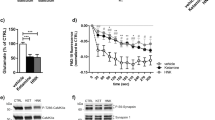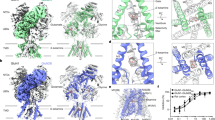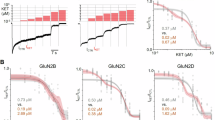Abstract
Ethanol is an antagonist of the N-methyl-D-aspartate (NMDA) glutamate receptor. Ethanol dependence upregulates NMDA receptors and contributes to crosstolerance with selective NMDA receptor antagonists in animals. This study evaluated whether recovering ethanol-dependent patients show evidence of a reduced level of response to the effects of the NMDA receptor antagonist, ketamine. In this double-blind study, 34 recently detoxified alcohol-dependent patients and 26 healthy comparison subjects completed 3 test days involving a 40-min infusion of saline, ketamine 0.1 mg/kg, or ketamine 0.5 mg/kg in a randomized order. Recovering ethanol-dependent patients showed reduced perceptual alterations, dysphoric mood, and impairments in executive cognitive functions during ketamine infusion relative to the healthy comparison group. No attenuation of ketamine-induced amnestic effects, euphoria, or activation was observed. The alterations in NMDA receptor function observed in recovering ethanol-dependent patients may have important implications for ethanol tolerance, ethanol dependence, and the treatment of alcoholism.
Similar content being viewed by others
Log in or create a free account to read this content
Gain free access to this article, as well as selected content from this journal and more on nature.com
or
References
Anand A, Charney DS, Cappiello A, Berman RM, Oren DA et al (2000). Lamotrigine attenuates ketamine effects in humans: support for hyperglutamatergic effects of NMDA antagonists. Arch Gen Psychiatry 57: 270–276.
Brown H, Prescott R (1999). Applied Mixed Models in Medicine. John Wiley and Sons: New York.
Crews FT, Morrow AL, Criswell H, Breese G (1996). Effects of ethanol on ion channels. Int Rev Neurobiol 39: 283–367.
Crews FT, Waage HG, Wilkie MB, Lauder JM (1999). Ethanol pretreatment enhances NMDA excitotoxicity in biogenic amine neurons: protection by brain derived neurotrophic factor. Alcoholism: Clin Exp Res 23: 1834–1842.
Darstein MB, Landwehrmeyer GB, Feuerstein TJ (2000). Changes in NMDA receptor subunit gene expression in the rat brain following withdrawal from forced long-term ethanol intake. Naunyn-Schmiedebergs Arch Pharmacol 361: 206–213.
Domino EF, Chodoff P, Corssen G (1965). Pharmacologic effects of CI-581, a new dissociative anesthetic, in man. Clin Pharmacol Ther 6: 279–291.
Follesa P, Ticku MK (1996a). Chronic ethanol-mediated up-regulation of the N-methyl-D-aspartate receptor polypeptide subunits in mouse cortical neurons in culture. J Biol Chem 271: 13297–13299.
Follesa P, Ticku MK (1996b). NMDA receptor upregulation: molecular studies in cultured mouse cortical neurons after chronic antagonist exposure. J Neurosci 16: 2172–2178.
Folstein MF, Folstein SE, McHugh PR (1975). Mini-mental state': a practical method of grading the cognitive state of patients for the clinician. J Psychiatr Res 12: 189.
Freund G, Anderson KJ (1996). Glutamate receptors in the frontal cortex of alcoholics. Alcoholism: Clin Exp Res 20: 1165–1172.
Ghoneim MM, Hinrichs JV, Mewaldt SP, Petersen RC (1985). Ketamine: behavioral effects of subanesthetic doses. J Clin Psychopharmacol 5: 70–77.
Gordon M (1983). Gordon Diagnostic Systems. Gordon Systems: DeWitt, New York.
Grambsch PM, Therneau TM (1994). Proportional hazards tests and diagnostics based on weighted residuals. Biometrika 81: 515–526.
Grant KA, Colombo G (1993). Discriminative stimulus effects of ethanol: effect of training dose on the substitution of N-methyl-D-aspartate antagonists. J Pharmacol Exp Ther 264: 1241–1247.
Grant KA, Lovinger DM (1995). Cellular and behavioral neurobiology of alcohol: receptor-mediated neuronal processes. Clin Neurosci 3: 155–164.
Grant KA, Snell LD, Rogawski MA, Thurkauf A, Tabakoff B (1992). Comparison of the effects of the uncompetitive N-methyl-D-aspartate antagonist (+−)-5-aminocarbonyl-10,11-dihydro-5H-dibenzo[a,d] cyclohepten-5,10-imine (ADCI) with its structural analogs dizocilpine (MK-801) and carbamazepine on ethanol withdrawal seizures. J Pharmacol Exp Ther 260: 1017–1022.
Gulya K, Grant KA, Valverius P, Hoffman PL, Tabakoff B (1991). Brain regional specificity and time-course of changes in the NMDA receptor-ionophore complex during ethanol withdrawal. Brain Res 547: 129–134.
Hedlund JL, Vieweg BW (1980). The Brief Psychiatric Rating Scale (BPRS): a comprehensive review. Journal of Operational Psychiatry 11: 48–64.
Hoffman PL, Rabe CS, Grant KA, Valverius P, Hudspith M, Tabakoff B (1990). Ethanol and the NMDA receptor. Alcohol 7: 229–231.
Hu XJ, Follesa P, Ticku MK (1996). Chronic ethanol treatment produces a selective upregulation of the NMDA receptor subunit gene expression in mammalian cultured cortical neurons. Brain Res Mol Brain Res 36: 211–218.
Hu XJ, Ticku MK (1995). Chronic ethanol treatment upregulates the NMDA receptor function and binding in mammalian cortical neurons. Brain Res Mol Brain Res 30: 347–356.
Hustveit O, Maurset A, Oye I (1995). Interaction of the chiral forms of ketamine with opioid, phencyclidine, sigma and muscarinic receptors. Pharmacol Toxicol 77: 355–359.
Kalluri HS, Mehta AK, Ticku MK (1998). Up-regulation of NMDA receptor subunits in rat brain following chronic ethanol treatment. Brain Res Mol Brain Res 58: 221–224.
Krupitsky EM, Burakov AM, Romanova TN, Grinenko NI, Grinenko AY, Fletcher J et al (2001). Attenuation of ketamine effects by nimodipine in recently detoxified ethanol dependent men: psychopharmacologic implications of the interaction of NMDA and L-type calcium channel antagonists. Neuropsychopharmacology 25: 936–947.
Krystal JH, D'Souza DC, Karper LP, Bennett A, Abi-Dargham A, Abi-Saab D et al (1999b). Interactive effects of subanesthetic ketamine and haloperidol. Psychopharmacology 145: 193–204.
Krystal JH, Karper LP, Seibyl JP, Freeman GK, Delaney R, Bremner JD et al (1994). Subanesthetic effects of the noncompetitive NMDA antagonist, ketamine, in humans. Psychotomimetic, perceptual, cognitive, and neuroendocrine responses. Arch Gen Psychiatry 51: 199–214.
Krystal J, Petrakis I, Krasnicki S, Trevisan L, Boustros N, D'Souza DC (1999a). Altered responses to agonists of the strychnine-insensitive glycine NMDA coagonist (SIGLY) site in recently detoxified alcoholics. Alcoholism: Clin Exp Res 22: 94A.
Krystal JH, Petrakis IL, Webb E, Cooney NL, Karper LP, Namanworth S et al (1998a). Dose-related ethanol-like effects of the NMDA antagonist, ketamine, in recently detoxified alcoholics. Arch Gen Psychiatry 55: 354–360.
Krystal JH, Petrakis IL, Webb E, Cooney NL, Karper LP, Namanworth S et al (1998b). Dose-related ethanol-like effects of the NMDA antagonist, ketamine, in recently detoxified alcoholics. Arch Gen Psychiatry 55: 354–360.
Krystal JH, Tabakoff B (2002). Ethanol abuse, dependence, and withdrawal: neurobiology and clinical implications. In: Davis KL, Charney DS, Coyle JT, Nemeroff C (eds) Psychopharmacology: A Fifth Generation of Progress. Lippincott Williams and Wilkins: Philadelphia, PA. pp 1425–1443.
Kucera H, Francis WN (1967). Computational Analysis of Present Day American English. Brown University Press: Providence, Rhode Island.
Liang KY, Zeger SL (1986). Longitudinal data analysis using generalized linear models. Biometrika 13–22.
Malhotra AK, Pinals DA, Weingartner H, Sirocco K, Missar CD, Pickar D et al (1996). NMDA receptor function and human cognition: the effects of ketamine in healthy volunteers. Neuropsychopharmacology 14: 301–307.
Michaelis EK, Michaelis ML, Freed WJ, Foye J (1993). Glutamate receptor changes in brain synaptic membranes during chronic alcohol intake. Alcohol Alcoholism 2(Suppl): 377–381.
Miller ME, Davis CS, Landis JR (1993). The analysis of longitudinal polytomous data: generalized estimating equations and connections with weighted least squares. Biometrics 49: 1033–1044.
Moghaddam B, Adams B, Verma A, Daly D (1997). Activation of glutamatergic neurotransmission by ketamine: a novel step in the pathway from NMDA receptor blockade to dopaminergic and cognitive disruptions associated with the prefrontal cortex. J Neurosci 17: 2921–2927.
Nestor PG, Faux SF, McCarley RW, Sands SF, Horvath TB, Peterson A (1991). Neuroleptics improve sustained attention in schizophrenia. A study using signal detection theory. Neuropsychopharmacology 4: 145–149.
Nestor PG, Faux SF, McCarley RW, Shenton ME, Sands SF (1990). Measurement of visual sustained attention in schizophrenia using signal detection analysis and a newly developed computerized CPT task. Schizophr Res 3: 329–332.
Newcomer JW, Farber NB, Jevtovic-Todorovic V, Selke G, Kelly Melson A, Hershey T et al (1999). Ketamine-induced NMDA receptor hypofunction as model of memory impairment and psychosis. Neuropsychopharmacology 20: 106–118.
Overall JE, Gorham DR (1962). The Brief Psychiatry Rating Scale. Psychol Rep 10: 799–812.
Oye I, Paulsen O, Maurset A (1992). Effects of ketamine on sensory perception: evidence for a role of N-methyl-D-aspartate receptors. J Pharmacol Exp Therap 260: 1209–1213.
Rafi-Tari S, Kalant H, Liu JF, Silver I, Wu PH (1996). Dizocilpine prevents the development of tolerance to ethanol-induced error on a circular maze test. Psychopharmacology 125: 23–32.
Schutz CG, Soyka M (2000). Dextromethorphan challenge in alcohol-dependent patients and controls. Arch Gen Psychiatry 57: 291–292.
Selzer ML (1971). The Michigan Alcoholism Screening Test: the quest for a new diagnostic instrument. Am J Psychiatry 127: 1653–1658.
Snell LD, Nunley KR, Lickteig RL, Browning MD, Tabakoff B, Hoffman PL (1996). Regional and subunit specific changes in NMDA receptor mRNA and immunoreactivity in mouse brain following chronic ethanol ingestion. Brain Res. Mol Brain Res 40: 71–78.
Snell LD, Tabakoff B, Hoffman PL (1993). Radioligand binding to the N-methyl-D-aspartate receptor/ionophore complex: alterations by ethanol in vitro and by chronic in vivo ethanol ingestion. Brain Res 602: 91–98.
Spitzer RL, Williams JBW, Gibbon M, First MB (1990). Structured Clinical Interview for DSM-III-R-Non-Patient Edition (SCID-NP, Version 1.0 with Supplement for DSM-IV). American Psychiatric Press: Washington, DC.
Spitzer RL, Williams JB, Gibbon M, First MB (1992). The Structured Clinical Interview for DSM-III-R (SCID). I: history, rationale, and description. Arch Gen Psychiatry 49: 624–629.
Thomas MP, Morrisett RA (2000). Dynamics of NMDAR-mediated neurotoxicity during chronic ethanol exposure and withdrawal. Neuropharmacology 39: 218–226.
Trevisan L, Fitzgerald LW, Brose N, Gasic GP, Heinemann SF, Duman RS et al (1994). Chronic ingestion of ethanol up-regulates NMDAR1 receptor subunit immunoreactivity in rat hippocampus. J Neurochem 62: 1635–1638.
Tsai G, Coyle JT (1998). The role of glutamatergic neurotransmission in the pathophysiology of alcoholism. Ann Rev Med 49: 173–184.
Tsai GE, Ragan P, Chang R, Chen S, Linnoila VM, Coyle JT (1998). Increased glutamatergic neurotransmission and oxidative stress after alcohol withdrawal. Am J Psychiatry 155: 726–732.
Vollenweider FX, Leenders KL, Oye I, Hell D, Angst J (1997). Differential psychopathology and patterns of cerebral glucose utilisation produced by (S)- and (R)-ketamine in healthy volunteers using positron emission tomography (PET). Eur Neuropsychopharmacol 7: 25–38.
von Knorring AL, Bohman M, von Knorring L, Oreland L (1985). Platelet MAO activity as a biological marker in subgroups of alcoholism. Acta Psychiatr Scand 72: 51–58.
Acknowledgements
This research was supported by Grants 1R01 AA10121-01, RO1 AA12308-01, KO2 AA 00261-01, and P50 AA12870-01 from the National Institute on Alcohol Abuse and Alcoholism (Bethesda, MD) (Drs Krystal, Petrakis), and the Department of Veterans Affairs (Washington, DC) through funding of the Department of Veterans Affairs Alcohol Research Center and a Merit Review Grant (Drs Krystal, Petrakis). We wish to acknowledge the critical contributions to this research made by the clinical and research staff of the Biostudies Unit and Substance Abuse Treatment Unit of the VA Connecticut Healthcare System (West Haven, CT). We also thank Robert Gibbons, PhD for his consultation to the data analysis plan.
Author information
Authors and Affiliations
Corresponding author
Rights and permissions
About this article
Cite this article
Krystal, J., Petrakis, I., Limoncelli, D. et al. Altered NMDA Glutamate Receptor Antagonist Response in Recovering Ethanol-Dependent Patients. Neuropsychopharmacol 28, 2020–2028 (2003). https://doi.org/10.1038/sj.npp.1300252
Received:
Revised:
Accepted:
Published:
Issue date:
DOI: https://doi.org/10.1038/sj.npp.1300252
Keywords
This article is cited by
-
Memantine in neurological disorders – schizophrenia and depression
Journal of Molecular Medicine (2021)
-
The effects of ketamine on prefrontal glutamate neurotransmission in healthy and depressed subjects
Neuropsychopharmacology (2018)
-
Non-Competitive NMDA Receptor Antagonist Hemantane Reduces Ethanol Consumption in Long-Term Alcohol Experienced Rats
Bulletin of Experimental Biology and Medicine (2017)
-
Aggression and increased glutamate in the mPFC during withdrawal from intermittent alcohol in outbred mice
Psychopharmacology (2015)
-
Glutamate and its receptors in the pathophysiology and treatment of major depressive disorder
Journal of Neural Transmission (2014)



